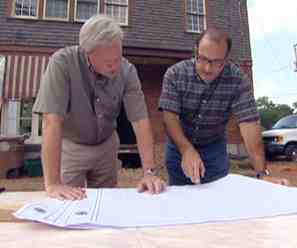
John Bleasby
Why do so many contractors despise architects (and vice-versa)?
Canadian ContractorLearning to work with an architect can sometimes be a contractor’s biggest challenge
I still remember my then-lead carpenter saying: “Know what I do when I get drawings from an architect? I throw them in the garbage!”
(Coincidentally, he soon became my ex– lead carpenter after announcing partway through the project that he was leaving for a month-long vacation in Italy with his wife. I told him not to hurry back.)
His remark typified the negativity with which some contractors view architects. And why relationships between those who design and those who execute are often worlds apart. It’s really a shame; the successful blend of design and construction talent is a common thread when researching Creative Eye, my regular feature in the print edition of Canadian Contractor. A successful collaboration can result in outstanding results.

The days of an architect drafting away in isolation are pretty much over. Now collaboration is key.
Perhaps some contractors have a basic misunderstanding of the architect’s role. And at the same time, perhaps some architects don’t fully appreciate the challenges of executing their design ideas with real materials.
The architect’s scope of work can vary
An architect’s scope of work can vary depending on their agreement with the client. Their most fundamental role is to develop conceptual drawings and later the final construction drawings that can be taken to the local building department for approval. However, whether the architect stays on to consult and observe the actual construction process is the open question. And then there’s the architect’s degree of understanding of building itself. “How are we supposed to frame that multi-dormer roof?” the builder might ask. Maybe the architect knows and neglected to provide a complete drawing, or maybe they assumed the builder would ‘figure it out on site.’ Fortunately, most experienced architects either have a practical understanding of construction themselves or have someone on staff who does.
Too many bids, misleading estimates
Architects often get involved in the budgeting and bidding process too, with mixed success. They can easily mislead a client early on into believing that their new home will come in at $400,000, whereas a builder might take one look at the drawings and say, “Nope, more like $475,000 to $500,000.” And if the architect then suggests sending out drawings to four or five builders for competitive quotes, the situation risks devolving into a street market of low-ball bids that can confuse the client and impact project quality.
However, on the positive side, the architect can help the client sort out competitive bids in terms of costs, quality and schedules, and clarify issues for bidding contractors. And for a contractor looking for quality work in the future, a good relationship with a busy architect is also good for business; Architects will often recommend contractors with whom they have enjoyed a good relationship in the past.
 Know what you’re getting into
Know what you’re getting into
It’s important for contractors to know how the architect intends to interact with the project. Are they simply designing, providing drawings, and then walking away? Or are they there for the duration and thus available as a go-to resource for the builder when the inevitable questions pop up? The difference is vitally important.
If the architect is hired to administer and ‘supervise’ the project while underway, it’s usually good news for both the client and the contractor. By visiting the work site regularly, a relationship of trust and understanding can develop that enables the efficient resolution of both major and minor issues. From the client’s standpoint, that means any required changes orders are moderated by a relatively unbiased party. For the contractor, it means that if a building inspector requires interpretation of say, a joist or truss layout, the architect can provide an explanation to everyone’s satisfaction.
 The best projects are built on a partnership of talents
The best projects are built on a partnership of talents
In an ideal world, builders and architects can learn a great from each other as the project continues. In fact, they should start working on the project from the beginning. That’s why a multiple free-for-all bidding competition can backfire so badly; an architect and contractor can be forced into a marriage that is doomed from the start.
In my particular case, my ‘former’ lead carpenter never appreciated my architect’s skills, never liked the design from the outset, and felt he could have come up with a better house himself. He wanted to be top dog, and openly ridiculed specific aspects of the design, offering his own solutions in conflict with the architect. In turn, the architect was dismissive of the carpenter and his comments, and understandably so. It was not a scenario for the ‘ideal build’, one more reason why the carpenter got the ‘heave-ho’ alluded to earlier.
Two viewpoints on design and construction are not necessarily bad things when engaged constructively. When taken to extremes bordering on rivalry for top dog status however, it only leads to stress for all concerned.
Let’s learn to play nicely together, OK?
follow John on Twitter @john_bleasby
Advertisement
Print this page

I just want to take a moment to comment on your article regarding the contractor -architect relationship. I am educated as an Architectural Technologist and used to work for Architects in the GTA area until the recession of the 1990’s when you could not buy a job and thus had to come home and work in the mechanical and electrical trades with my father. An environment that I was used to and worked in since I was the age of 9. I also had a good background in carpentry and drafting as a result of my high school technical education.
This experience coupled with my architectural experience gave me the prescence of mind to work as a troubleshooter in my many different jobs working for Architects.
My point that I want to make is that there are many good Architects out in the industry. There is also the other end of the scale as there is with many things. At the time when I was working in this field, new Architects were only taught one semester of producing working drawing documents. We on the other hand as Architectural Technologists and Technicians study this field for three years and two year respectively. In the USA, Technologists are referred to Architectural Engineers which I think is a more fitting title to our education and experience.
An Architect’s education is very good in the concepts of design that deals with form, harmony and asthetics, and the history of architecture, but does in my opinion from experience in the past did lack in the area of building science and construction related documents. The answer to this situation is the Architectural Technologists and Technicians that perform this task. My point is that you do not need a Architect to do house drawings , but today you must have other accreditations do to liabilities of the design work and the structural conditions of the design. Many Technologists and Technicians are employed by Architects for this very purpose. Further, many Technologist work independently on there own or perhaps as a separate contractor to an Architect because they have a better understanding of building components and their interaction in a structure. When this relationship is able to work then you have the ultimate RESPECT that is needed in the industry to promote a good relationship. Rather than just referring to these key personnel as staffers I think you need to do some research on the educational background of Architectural Technologists and Technicians. Perhaps visit some Colleges and see the extent of their training.